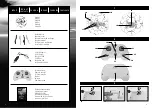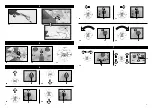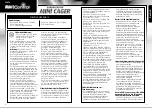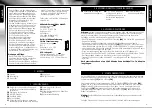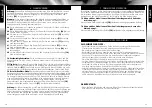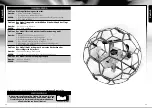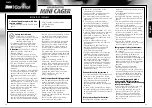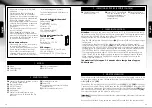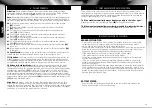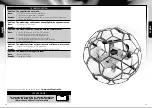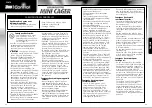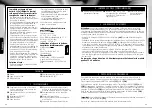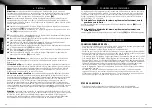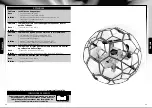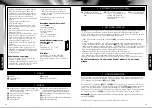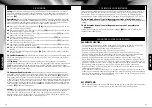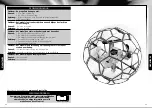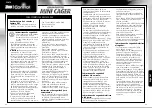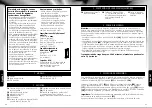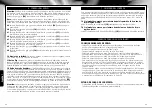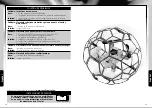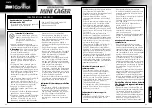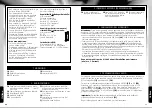
English
INSTRUCTIONS FOR SAFE FLYING
GENERAL FLYING TIPS:
• Always place the model on a level surface. An inclined surface can, under certain
circumstances, have a negative impact on the starting behavior of the model.
• Always operate the controls slowly and with a gentle touch.
• Always maintain visual contact with the model and do not look at the remote control!
• Move the thrust control down again somewhat as soon as the model lifts off from
the ground. Maintain flying altitude by adjusting the thrust controller.
• If the model lowers, move the thrust control slightly upward again.
• If the model climbs, move the thrust control down slightly.
• To fly along a curve, tapping the directional controller very slightly in the respective
direction often suffices.
There is a general tendency during preliminary attempts at flight to operate the
model‘s controls too aggressively.Always operate the controls slowly and carefully.
Never fast and fitfully.
• Beginners should first master trimming before attempting to master the thrust controller.
The model does not necessarily have to fly straight at the beginning - initially, it is
more important to maintain a constant height of approximately one meter above the
ground by repeatedly tapping the thrust control. Only then should the pilot practice
steering the model left and right.
6 FLIGHT CONTROL
Attention:
Due to outside influences, the pressure inside the model may change,
causing the model to automatically rise or lower. This is not a defect. Briefly actuating
the control for thrust and rotation
(2A)
is sufficient to counteract this.
Note:
Only minimal corrections of the controls are necessary for a smooth flying behavior
of the model! The direction indication applies when the model is viewed from behind. If
the model is flying forwards towards the pilot, it must be moved in the opposite direction.
6A
To take off or gain altitude, carefully move the control for thrust and rotation
(2A)
forwards.
6B To land or lose altitude, carefully move the control for thrust and rotation
(2A)
backwards.
6C
Fly forward by moving the controller for forward/backward and sideways
flight
(2F)
carefully forward.
6D
Fly backward by moving the controller for forward/backward and sideways
flight
(2F)
carefully backward.
6E
Fly to the left by moving the controller for forward/backward and sideways
flight
(2F)
carefully to the left.
6F
Fly to the right by moving the controller for forward/backward and sideways
flight
(2F)
carefully to the right.
6G
Turn the model around to the left by moving the control for thrust and rotation
(2A)
to the left.
6H
Turn model around to the right by moving the control for thrust and rotation
(2A)
to the right.
2A Speed levels:
By pressing in the control for thrust and rotation, you activate the
second and then the third level and then go back to the first speed level.
2F Flip button:
Each time you press in the forward/reverse and banking control, the
model performs a flip in the direction in which the control for forwards/reverse and
banking
(2F)
is moved immediately afterwards. Only activate this function if there is
enough space available and the model is flying at a height of at least 2 meters.
2D Button for Headless Mode:
Headless mode supports beginners in the initial
stages. Regardless of where the quadrocopter turns, the direction of flight always
corresponds exactly to the direction specified with the control for forwards/backwards
and sideways movement
(2F)
. An example: If the model were to be turned 180°
and flown towards the operator, the operator would have to „convert“ the forwards/
backwards and sideways movement accordingly. This is no longer necessary if head-
less mode is activated, as the internal processor always converts the control directions
automatically. Another press of the button
(2D)
deactivates the mode and the front LEDs
(1C)
now stay illuminated again.
Attention:
The model „notes“ the forwards direction during each switch-on. This
means that the operator must not turn when controlling the model, as this would
change the concept of „forwards“ and „right/left“ in relation to the model. If the operator
changes position and wants to use headless mode - or if the control direction is no longer
correct due to a collision, the model must be restarted.
The model must be switched on first in order to connect it to the remote control.
Its adjustment is simple, but it requires some patience and a feel for it. Please observe
the following instructions precisely: Carefully move the thrust control up and raise the
helicopter approximately 0.5 to 1 metre in altitude.
7 TRIM ADJUSTMENT OF THE CONTROL
7B If the model automatically moves slowly or quickly forwards or backwards ...
gradually press the forwards/backwards trim
(2G)
in the opposite direction.
7A If the model automatically moves slowly or quickly to the left or right ...
gradually press the trim for sideways flight
(2B)
in the opposite direction.
English
BATTERY STATUS:
• If the front LEDs are flashing and the red LED on the rear of the model lights up, the
battery is nearly empty. Land to avoid crashing.
18
19


